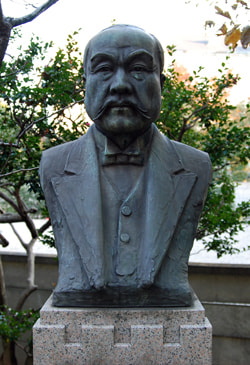
Bust of Shuji Isawa
The bust of Shuji Isawa, who made every effort to establish Tokyo Music School and became the first president of the school, is now placed next to Sogakudo Concert Hall. This statue was built in 1930 based on the idea of then President Kaju Norisugi, commemorating the 50th anniversary of the foundation of the school. At that time, the statue was placed close to the entrance gate, facing the facade of the school building. It is said that some students made a bow to the sculpture and entered the building when attending the school.
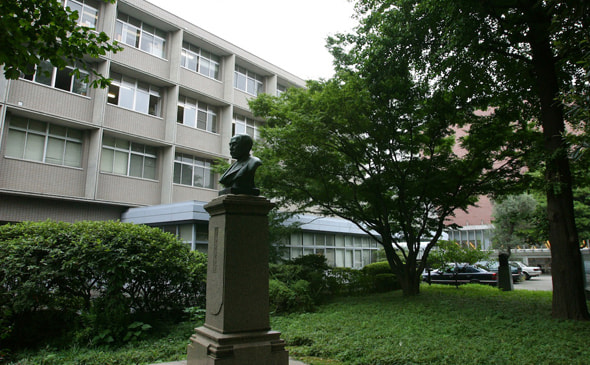
Verdant Grounds of the Faculty of Music
Tokyo Music School, the predecessor of the Faculty of Music, was established in October 1879 as "Ongaku Torishirabe Gakari," or Music Investigation Committee, which was under the control of the Ministry of Education. Its objective was to research what is needed to conduct music education in Japan, and Shuji Isawa, who became the first president of Tokyo Music School, was put in charge of the committee. In March 1880, the committee office was set up at the Ministry of Education's land in Hongo, and it began to conduct classes for students of elementary schools attached to Tokyo Normal School and Tokyo Normal School for Girls and of kindergartens as well as starting many projects, including research of domestic and international music. Also, the committee began to recruit its students, conduct music classes and foster teachers. Since September 1882, the committee adopted a four-year music education system after researching music education systems in other countries, and grew as not only a music research institute but also the first modern music education institution in Japan. Then, the committee became "Ongaku Torishirabe Sho" in February 1885 and "Ongaku Torishirabe Gakari" in December of that year, and was renamed Tokyo Music School in October 1887. The school moved to the site (the present location) where Nishi Shikendera Temple previously stood in May 1890. Although Tokyo Music School became a music school attached to the Tokyo Higher Normal School in 1893, it became an independent school again in April 1899. The Department of Traditional Japanese Music was established in June 1936, and the music school was merged into Tokyo National University of Fine Arts and Music (present-day Tokyo University of the Arts) in March 1952 after reforming its system several times. At first, Tokyo Music School was a specialist school which had four-year regular courses (Department of Vocal Music, Department of Instrumental Music [Piano, Organ, Strings Instruments, Wind Instruments and Percussion Instruments], Department of Composition and Department of Traditional Japanese Music [Noh, Koto Music and Nagauta]), four-year teachers' courses, two-year research courses (Division of Vocal Music, Division of Instrumental Music, Division of Composition and Division of Traditional Japanese Music) and elective courses (1 to 5 years) of which objective was to give simplified technical education to students.
For the history of Tokyo Music School, refer to "history, Touring Sogakudo of the Former Tokyo Music School."
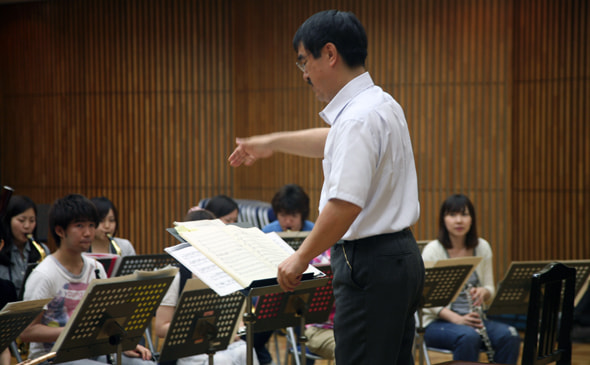
Scene of a class: Students practice everyday with enthusiasm.
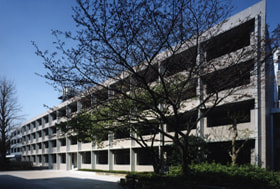
Building 3, Faculty of Music
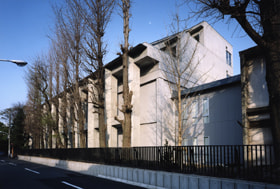
Practice Hall
Tokyo Music School Continuation or Abolition Dispute
Tokyo Music School was established in October 1887 as a school that came directly under the Ministry of Education, and the new school building was also completed in May 1890. However, too soon, a bill for abolishing the music school was submitted to the first Imperial Diet that was opened in the same year. It was due to budget cuts. Then, the Tokyo Music School continuation or abolition dispute began. The existence of the school itself was called into question, and it was the unmatched incident in the history of the school.
The first Imperial Diet was opened on November 29, 6 months after Sogakudo Concert Hall was established, and Tokyo Music School did its utmost to give a celebratory concert. However, soon after the diet began, a bill for abolishing higher middle schools, normal schools for girls and Tokyo Music School, which was intended to cut budgets, was submitted to the Standing Committee on Budget of the House of Representatives.
The Tokyo Music School continuation or abolition dispute started from House of Representatives member Yukimoto Kudo's statement, "I submit a bill that requires an abolition of Tokyo Music School," who had an opinion that the government does not need to support the music education that can be provided by private schools. The music school abolition bill submitted to the Diet was widely reported in newspapers, and the benefits of music and the need for the music school were argued. On January 13 the following year, a motion against the bill, an objection to abolishing the music school and an amendment bill were submitted to the Diet, and the Tokyo Music School continuation or abolition dispute became heated further. During this time, the school officials, including Shuji Isawa and Senzaburo Kozu, and other people, including Vice-Minister of Education Shinji Tsuji, made arguments that the music school is necessary. Before this, the House of Representatives selected 9 extraordinary members and entrusted the budget bill reexamination to them. One of the members, House of Representatives member Tameyuki Amano reported that 3 extraordinary members, including himself, oppose the abolition of the school. On February 21, the amendment bill was adopted and continuation of the concerned schools was decided. On March 3, the House of Representatives approved the amendment bill that was submitted by the extraordinary members. In March, House of Representatives members visited the music school. President Isawa himself explained about a concert program, and made a speech stating that songs for school music classes cultivate moral character, benefit health and nurture a sense of patriotism, emphasizing a role of the music school in compiling of the songs and other projects.
Even after the continuation of the music school was decided, discussions about the music school were repeatedly released. Statements, including "Strive further," "The time comes," "Discussion about songs for school music classes," "Necessity of music" and "Music is a national project," which express a sense of hope for the music school, were declared one after the other. However, at the same time, opinions requiring cost reductions were repeatedly voiced, and Tokyo Music School became an music school attached to the Tokyo Higher Normal School in September 1893. It took five and a half years for the music school to be an independent school again in April 1899. (Cited from Tokyo University of the Arts' public relations magazine "Geidai Tsushin, 12th Issue")

Bust of Shuji Isawa
The bust of Shuji Isawa, who made every effort to establish Tokyo Music School and became the first president of the school, is now placed next to Sogakudo Concert Hall. This statue was built in 1930 based on the idea of then President Kaju Norisugi, commemorating the 50th anniversary of the foundation of the school. At that time, the statue was placed close to the entrance gate, facing the facade of the school building. It is said that some students made a bow to the sculpture and entered the building when attending the school.
Tokyo Music School Continuation or Abolition Dispute
Tokyo Music School was established in October 1887 as a school that came directly under the Ministry of Education, and the new school building was also completed in May 1890. However, too soon, a bill for abolishing the music school was submitted to the first Imperial Diet that was opened in the same year. It was due to budget cuts. Then, the Tokyo Music School continuation or abolition dispute began. The existence of the school itself was called into question, and it was the unmatched incident in the history of the school.
The first Imperial Diet was opened on November 29, 6 months after Sogakudo Concert Hall was established, and Tokyo Music School did its utmost to give a celebratory concert. However, soon after the diet began, a bill for abolishing higher middle schools, normal schools for girls and Tokyo Music School, which was intended to cut budgets, was submitted to the Standing Committee on Budget of the House of Representatives.
The Tokyo Music School continuation or abolition dispute started from House of Representatives member Yukimoto Kudo's statement, "I submit a bill that requires an abolition of Tokyo Music School," who had an opinion that the government does not need to support the music education that can be provided by private schools. The music school abolition bill submitted to the Diet was widely reported in newspapers, and the benefits of music and the need for the music school were argued. On January 13 the following year, a motion against the bill, an objection to abolishing the music school and an amendment bill were submitted to the Diet, and the Tokyo Music School continuation or abolition dispute became heated further. During this time, the school officials, including Shuji Isawa and Senzaburo Kozu, and other people, including Vice-Minister of Education Shinji Tsuji, made arguments that the music school is necessary. Before this, the House of Representatives selected 9 extraordinary members and entrusted the budget bill reexamination to them. One of the members, House of Representatives member Tameyuki Amano reported that 3 extraordinary members, including himself, oppose the abolition of the school. On February 21, the amendment bill was adopted and continuation of the concerned schools was decided. On March 3, the House of Representatives approved the amendment bill that was submitted by the extraordinary members. In March, House of Representatives members visited the music school. President Isawa himself explained about a concert program, and made a speech stating that songs for school music classes cultivate moral character, benefit health and nurture a sense of patriotism, emphasizing a role of the music school in compiling of the songs and other projects.
Even after the continuation of the music school was decided, discussions about the music school were repeatedly released. Statements, including "Strive further," "The time comes," "Discussion about songs for school music classes," "Necessity of music" and "Music is a national project," which express a sense of hope for the music school, were declared one after the other. However, at the same time, opinions requiring cost reductions were repeatedly voiced, and Tokyo Music School became an music school attached to the Tokyo Higher Normal School in September 1893. It took five and a half years for the music school to be an independent school again in April 1899. (Cited from Tokyo University of the Arts' public relations magazine "Geidai Tsushin, 12th Issue")



















